Title “Organic Fertilizers” in Vietnam’s Markets: Nutrient Composition and Efficacy of Their Application
Abstract
:1. Introduction
2. Materials and Methods
2.1. Sampling and Chemical Analysis
2.2. Investigation of the Flow of Raw Materials and Manufacturing Process of an “Organic Fertilizer”
2.3. Cultivation Experiments
3. Results and Discussion
3.1. Characteristics of “Organic Fertilizers”
3.2. Production Method of an “Organic Fertilizer” from Coffee By-Products
3.3. Effects of “Organic Fertilizers” on Plant Growth and N Leaching
4. Conclusions and Implications
Author Contributions
Funding
Acknowledgments
Conflicts of Interest
References
- Parvathi, P.; Waibel, H. Fair trade and organic agriculture in developing countries: A review. J. Int. Food Agribus. Mark. 2013, 25, 311–323. [Google Scholar] [CrossRef]
- Rehber, E.; Turhan, S. Prospects and challenges for developing countries in trade and production of organic food and fibers: The case of Turkey. Br. Food J. 2002, 104, 371–390. [Google Scholar] [CrossRef]
- Dam, N.D.; Canh, D.X.; Ha, N.T.T.; van Tan, N.; Thieu, N.D. Vietnam organic agriculture: An overview on current status and some success activities. In Proceedings of the 4th ANSOFT Workshop—Gwangju, Jeonam, Korea, 18–20 October 2012. [Google Scholar]
- Dam, N.D. Production and Supply Chain Management of Organic Food in Vietnam. Available online: http://www.fftc.agnet.org/library.php?func=view&id=20150728143506&type_id=4 (accessed on 20 December 2017).
- The World Bank: Vietnam-Context. Available online: http://www.worldbank.org/en/country/vietnam/overview#1 (accessed on 1 April 2018).
- Tien, T.M. Vietnam soil resources. In Proceedings of the Asian Soil Partnership Consultation Workshop on Sustainable Management and Protection of Soil Resources, Bangkok, Thailand, 13–15 May 2015; Available online: http://www.fao.org/fileadmin/user_upload/GSP/docs/asia_2015/Vietnam.pdf (accessed on 1 April 2018).
- Kazuto, S.; Binh, N.T.; Quynh, H.T.; Yu, H. The effects of land-use change for rubber plantation on physical properties of surface soil in Central Vietnam. In Proceedings of the Japan—Vietnam Research Workshop on Sustainable Society Development in Asian Countries Talking Climate Change, Ho Chi Minh City, Vietnam, 2–3 November 2015. [Google Scholar]
- Vu, Q.M.; Le, Q.B.; Frossard, E.; Vlek, P.L.G. Socio-economic and biophysical determinants of land degradation in Vietnam: An integrated causal analysis at the national level. Land Use Policy 2014, 36, 605–617. [Google Scholar] [CrossRef]
- Nguyen, T.T.; Bauer, S.; Grote, U. Does land tenure security promote manure use by farm households in Vietnam? Sustainability 2016, 8, 178. [Google Scholar] [CrossRef] [Green Version]
- Ho, T.Q.; Hoang, V.; Wilson, C.; Nguyen, T. Eco-efficiency analysis of sustainability-certified coffee production in Vietnam. J. Clean. Prod. 2018, 183, 251–260. [Google Scholar] [CrossRef]
- Mordor Intelligence. Vietnam Organic Fertilizers Market (2016–2021), a Sample Report 2017. Available online: https://www.mordorintelligence.com/industry-reports/vietnam-fertilizers-market (accessed on 5 October 2017).
- Doan, T. Fertilizer Industry Report, 2015. Available online: http://www.fpts.com.vn/FileStore2/File/2015/08/11/FPTS-Fertilizer%20Industry%20Report.2015.pdf (accessed on 5 October 2017).
- Viet Nam News: Experts Urge Organic Fertilizer Use. Available online: http://vietnamnews.vn/economy/405614/experts-urge-organic-fertiliser-use.html#Kz12tHuMf9qzWFlJ.97 (accessed on 5 October 2017).
- Thanh, N.P.; Matsui, Y. Municipal solid waste management in Vietnam: Status and the strategic actions. Int. J. Environ. Res. 2011, 5, 285–296. [Google Scholar] [CrossRef]
- Dzung, N.A.; Dzung, T.T.; Khanh, V.T.P. Evaluation of coffee husk compost for improving soil fertility and sustainable coffee production in rural Central Highland of Vietnam. Resour. Environ. 2013, 3, 77–82. [Google Scholar]
- Quynh, H.T.; Kazuto, S.; Binh, N.T. Evaluation of composted municipal solid waste for agricultural use in Vietnam. J. Adv. Agric. Technol. 2018, 5, 14–18. [Google Scholar] [CrossRef]
- Kokkora, M.I.; Hann, M.J. Crop production and nitrogen leaching resulting from biowaste and onion compost amended sand. In Proceedings of the Eleventh International Waste Management and Landfill Symposium, Cagliari, Italy, 1–5 October 2007. [Google Scholar]
- Mamo, M.; Rosen, C.J.; Halbach, T.R. Nitrogen availability and leaching from soil amended with municipal solid waste compost. Environ. Qual. 1998, 28, 1074–1082. [Google Scholar] [CrossRef]
- Golabi, M.H.; Denney, M.J.; Iyekar, C. Value of composted organic waste as an alternative to synthetic fertilizers for soil quality improvement and increased yield. Compos. Sci. Util. 2007, 15, 267–271. [Google Scholar] [CrossRef]
- Hepperly, P.; Lotter, D.; Ulsh, C.Z.; Seidel, R.; Reider, C. Compost, manure and synthetic fertilizer influences crop yields, soil properties, Nitrate leaching and crop nutrient content. Compos. Sci. Util. 2009, 17, 117–126. [Google Scholar] [CrossRef]
- Nguyen, T.T.; Ruidisch, M.; Koellner, T.; Tenhunen, J. Synergies and tradeoffs between nitrate leaching and net farm income: The case of nitrogen best management practices in South Korea. Agric. Ecosyst. Environ. 2014, 186, 160–169. [Google Scholar] [CrossRef]
- Carter, M.R.; Gregorich, E.G. Chapter 6 nitrate and exchangeable ammonium nitrogen. In Soil Sampling and Methods of Analysis, 2nd ed.; CRC Press: Boca Raton, FL, USA, 2007; pp. 71–80. [Google Scholar]
- Doane, T.A.; Horwa´th, W.R. Spectrophotometric determination of nitrate with a single reagent. Anal. Lett. 2003, 36, 2713–2722. [Google Scholar] [CrossRef]
- Tan, K.H. Chapter 10 determination of macroelements. In Soil Sampling, Preparation, and Analysis; CRC Press: Boca Raton, FL, USA, 1996. [Google Scholar]
- Clapp, C.E.; Hayes, M.H.B.; Ciavatta, C. Organic waste in soils: Biogeochemical and environmental aspects. Soil Biol. Biochem. 2007, 39, 1239–1243. [Google Scholar] [CrossRef]
- Decision 36/2007/QĐ-BNN. Regulations Regarding Fertilizer Production, Distribution and Use; Ministry of Agricultural and Rural Development: Hanoi, Vietnam, 2007. (In Vietnamese) [Google Scholar]
- Nutrient Value of Compost. Available online: http://vric.ucdavis.edu/events/2009_osfm_symposium/UC%20Organic%20Symposium%20010609%2005b%20Hartz.pdf (accessed on 10 March 2018).
- Kuo, S.; Ortiz-Escobar, M.E.; Hue, N.V.; Hummel, R.L. Composting and Compost Utilization for Agronomic and Container Crops. Available online: https://www.ctahr.hawaii.edu/huen/composting_compost_util.pdf (accessed on 20 October 2017).
- Al-Bataina, B.B.; Young, T.M.; Ranieri, E. Effects of compost age on the release of nutrients. Int. Soil Water Conserv. Res. 2016, 4, 230–236. [Google Scholar] [CrossRef]
- Horrocks, A.; Curtin, D.; Tregurtha, C.; Meenken, E. Municipal compost as a nutrient source for organic crop production in New Zealand. Agronomy 2016, 6, 35. [Google Scholar] [CrossRef]
- Amlinger, F.; Götz, B.; Dreher, P.; Geszti, J.; Weissteiner, C. Nitrogen in biowaste and yard waste compost: Dynamics of mobilization and availability—A review. Eur. J. Soil Biol. 2003, 39, 107–116. [Google Scholar] [CrossRef]
- Hartz, T.K.; Mitchell, J.P.; Giannini, C. Nitrogen and carbon mineralization dynamics of manures and composts. HortScience 2000, 35, 209–212. [Google Scholar]
- Cofie, O.; Nikiema, J.; Impraim, R.; Adamtey, N.; Paul, J.; Koné, D. Co-composting of solid waste and fecal sludge for nutrient and organic matter recovery. In Resource Recovery and Reuse Series 3; CGIAR Research Program on Water, Land and Ecosystems: Colombo, Sri Lanka, 2016; pp. 22–24. [Google Scholar]
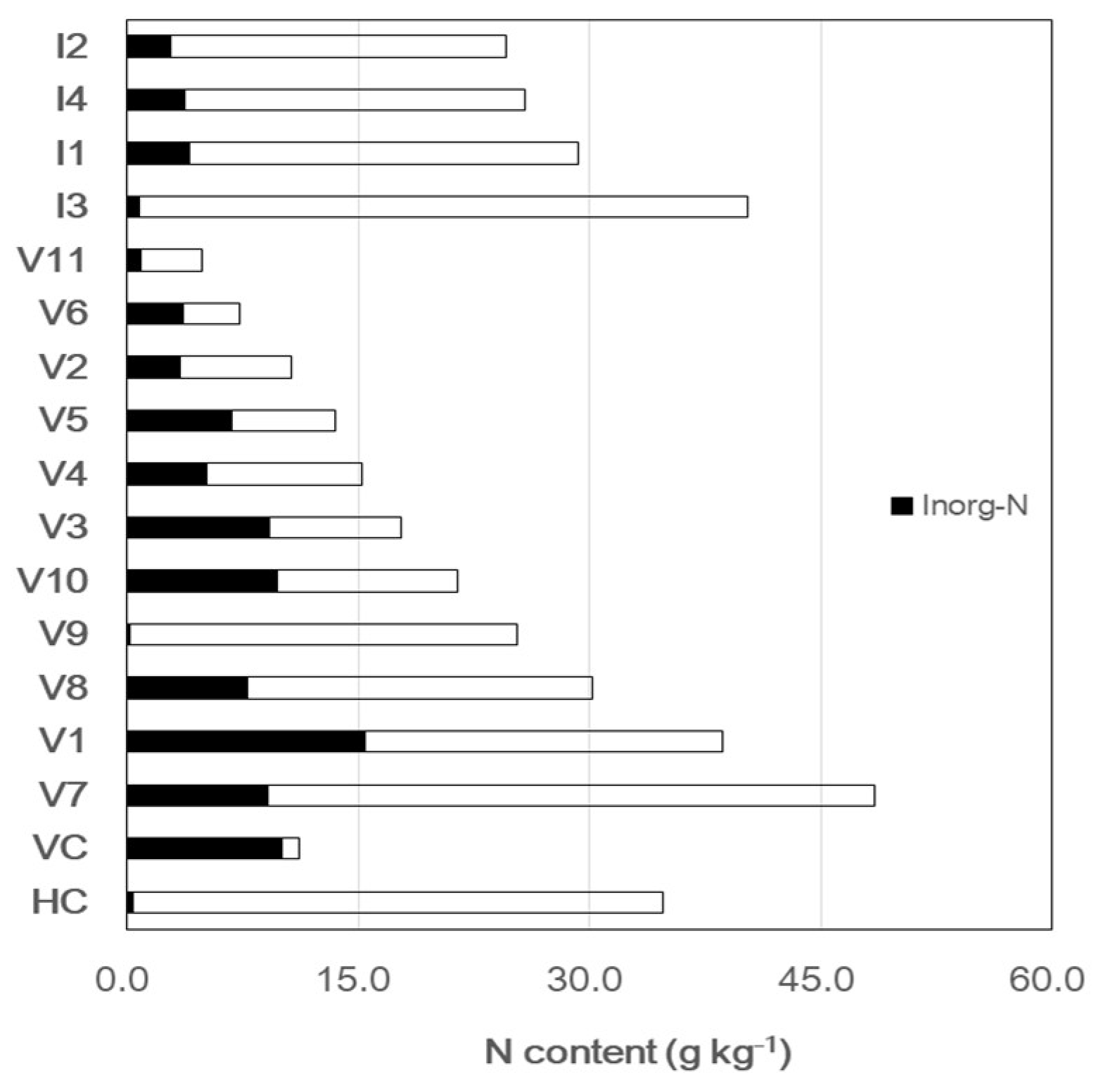
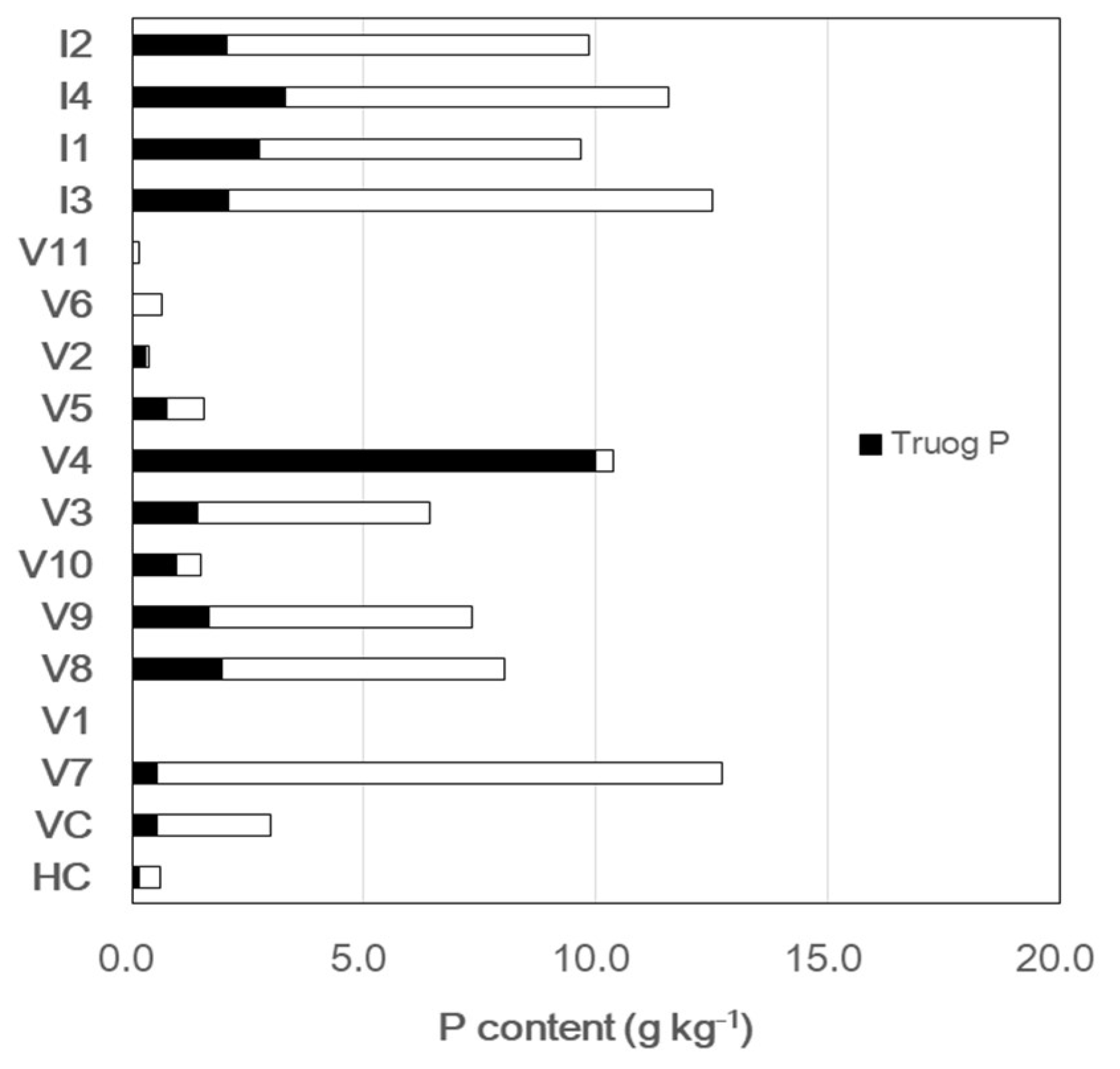
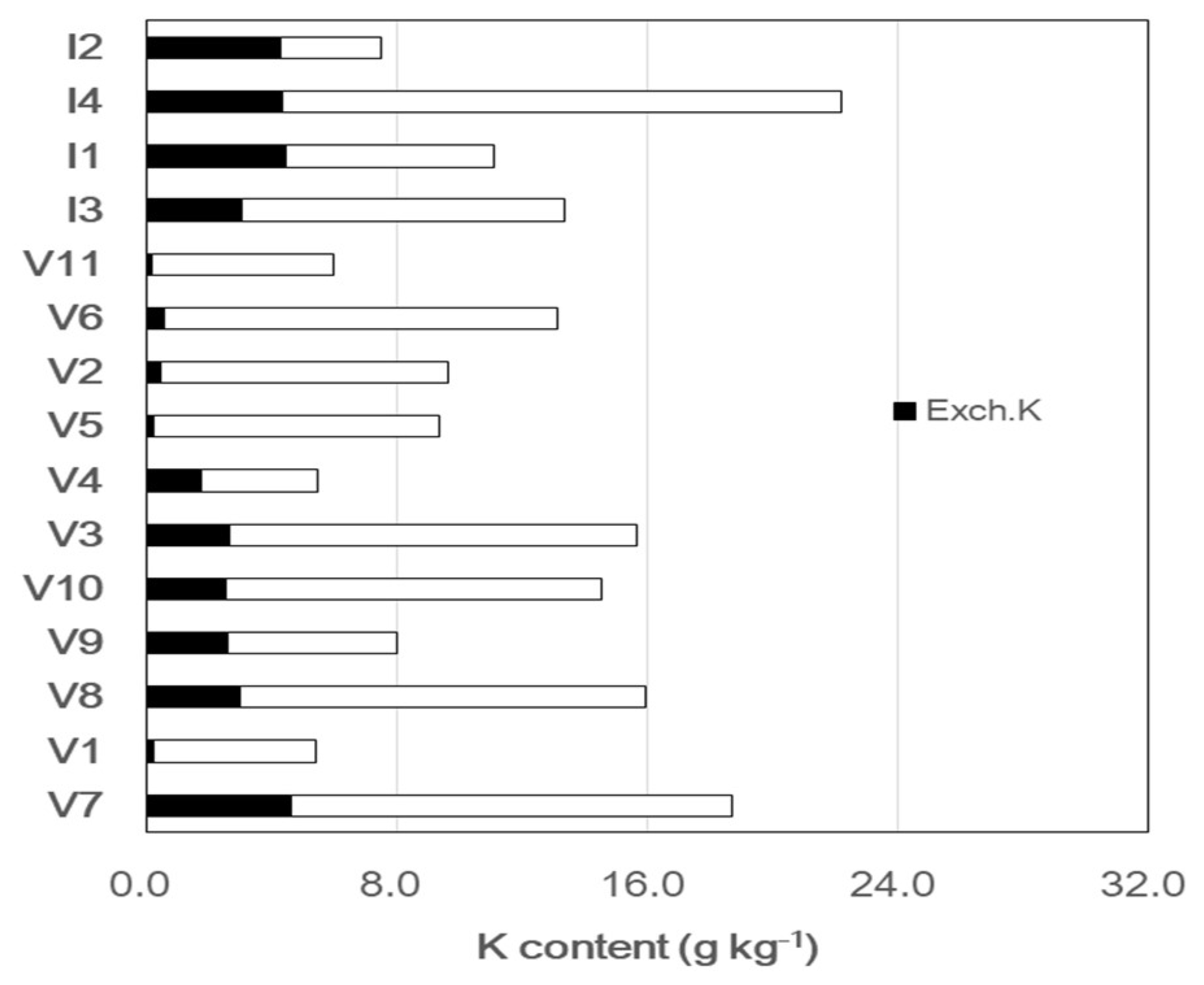

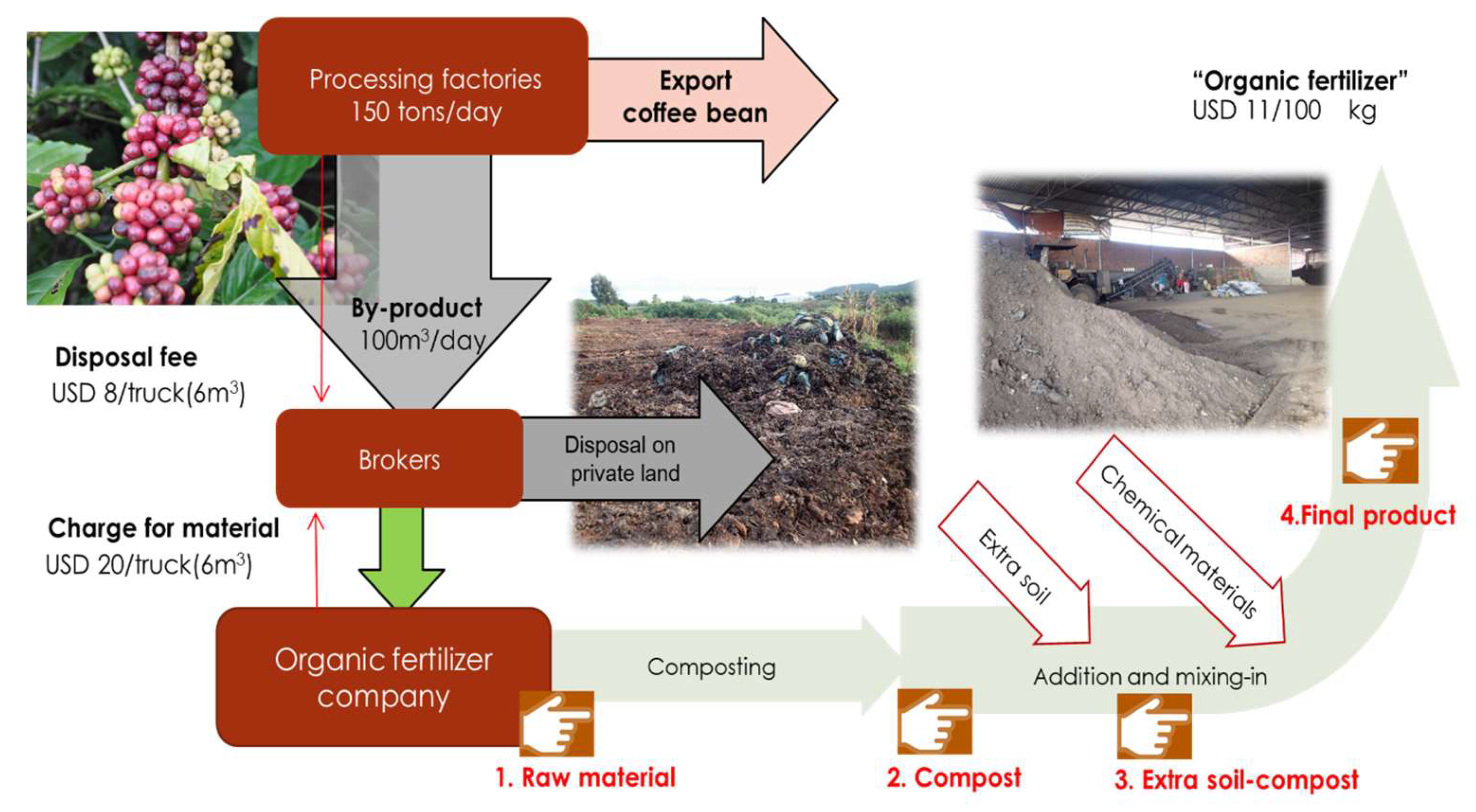
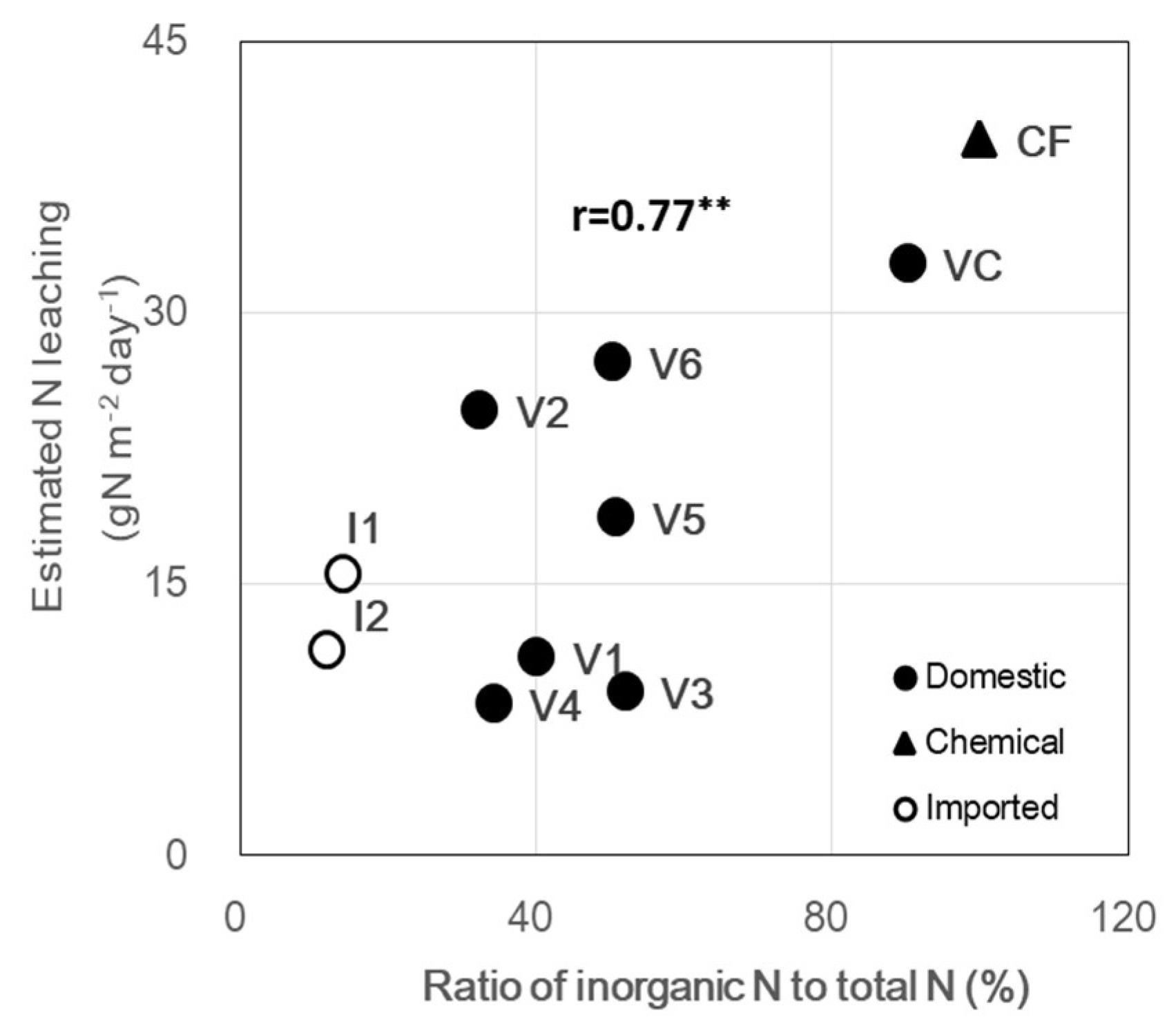
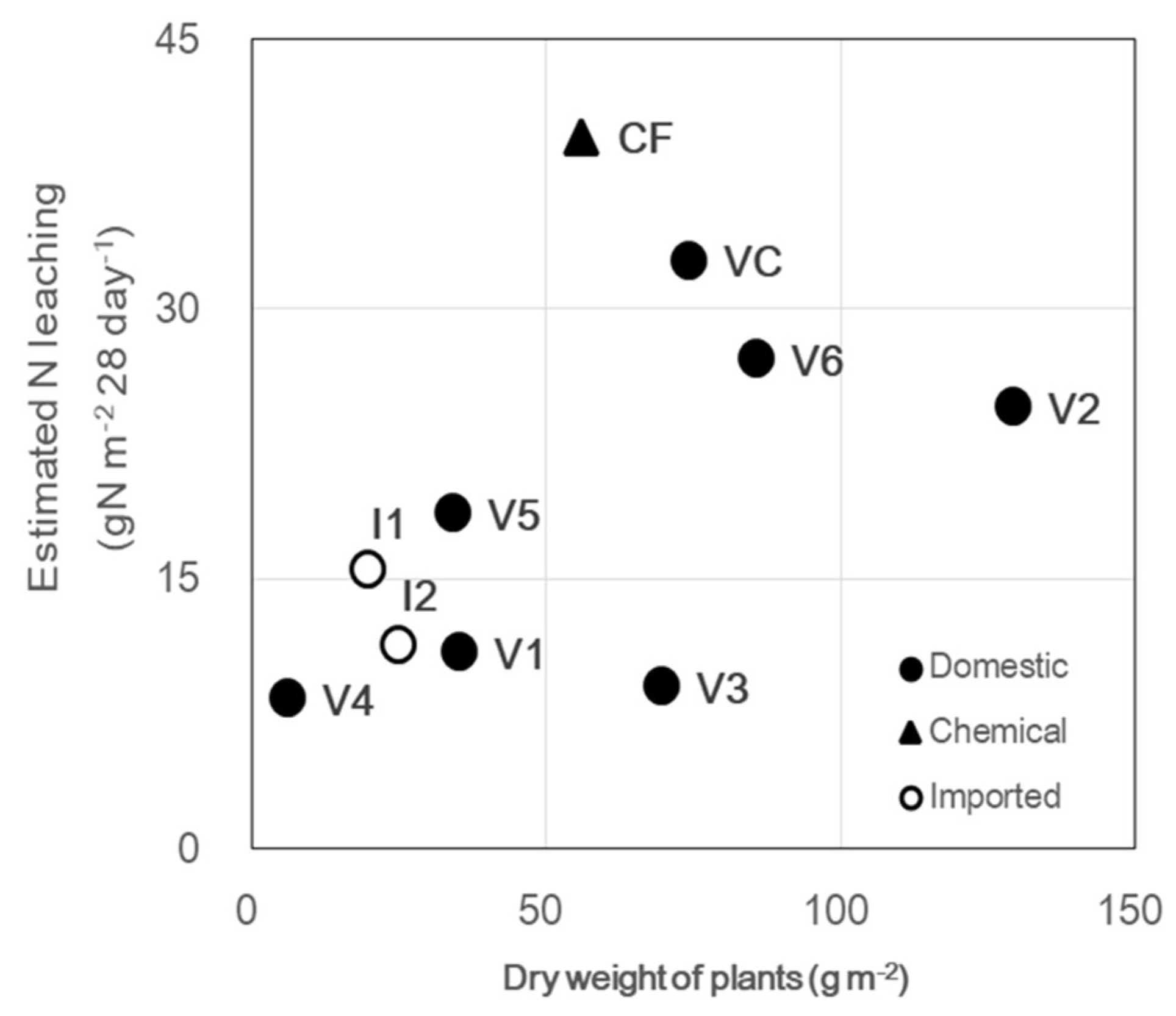
| Constituents | Values |
|---|---|
| pH (H2O) | 8.99 ± 0.17 |
| Total C | ≤0.001 |
| Total N | ≤0.001 |
| Total P | 0.01 ± 0.00 |
| Total K | 2.26 ± 0.04 |
| Total Mg | 1.72 ± 0.00 |
| Total Ca | 3.24 ± 0.10 |
| Domestic Products | Imported Products | |||
|---|---|---|---|---|
| pH (H2O) | 7.22 | (5.14~9.07) | 8.35 | (7.40~8.97) |
| C:N ratio | 8.88 | (3.22~19.43) | 9.16 | (7.71~10.62) |
| Total Ca | 28.45 | (10.44~61.78) | 60.14 | (40.29~69.59) |
| Exch.Ca | 0.02 | (0.00~0.05) | 0.04 | (0.03~0.05) |
| Total Mg | 3.88 | (0.88~7.19) | 5.20 | (4.34~6.40) |
| Exch.Mg | 2.40 | (0.13~5.77) | 3.92 | (2.91~4.40) |
| Product Name | Sample Label | Ingredient Descriptions | Foreign Objects Mixed in Products | Product Shape, Instructions for Use | Market Price (USD/kg) |
|---|---|---|---|---|---|
| Domestic products | |||||
| TRIMIX—N1 | V7 | Without indication | Small granules, For horticulture | 1.46 | |
| SONG HUONG | V1 | Without indication | Small pieces of branches and litter | Small granules, For all crops | 0.09 |
| HADICO—THANG LONG 03 | V8 | Without indication | Small pieces of branches and litter | Small granules, For horticulture | 0.33 |
| CFARM Pb02 | V9 | Without indication | Small pieces of wood and nylon | Small granules, For vegetables, horticulture | 0.56 |
| TRIBAT T—O | V10 | Without indication | Small granules, For all crops | 0.40 | |
| DAU TRAU HCMK7-HUU CO TRICHODERMA + TE | V3 | Without indication | Small granules, For all crops | 1.56 | |
| ORMIC 02—TRICHODERMAR sp—AZOTOBACTER sp | V4 | Without indication | Fine powder For all crops | 2.22 | |
| HUU CO VI SINH MOI TRUONG HA NOI | V5 | Without indication | Small pieces of wood | Small granules, For vegetables, horticulture | 0.22 |
| SONG GIANH 1 | V2 | Without indication | Small pieces of stone | Small granules, For all crops | 0.18 |
| QUE LAM 01 | V6 | Residue of crops, fish, and seaweed | Small pieces of wood | Small granules, For all crops | 0.44 |
| SONG GIANH 2 | V11 | Without indication | Small pieces of wood, branches, stone | Small granules, For horticulture | 0.22 |
| PHAN CA PHE | VC | Coffee by-products | For vegetables | 0.11 | |
| Imported products | |||||
| MIEN TAY—WOPROFERT (Holland) | I3 | Without indication | For all crops | 2.22 | |
| NEUTROG—RAPID RAISER (Australia) | I1 | Without indication | Pieces of rice husks | For all crops | 2.22 |
| VIMAX 3-3-3 (Malaysia) | I4 | Without indication | For vegetables, fruits, tobacco, coffee tree, flowers, and rice | 2.22 | |
| NEUTROG—BOUNCO BACK (Australia) | I2 | Without indication | Pieces of rice husks | For all crops | 2.22 |
| Raw Material | After Composting | After Bulking out | Final Product | |
|---|---|---|---|---|
| pH | NA# | 8.51 | 8.03 | 9.01 |
| Total C | 423.20 | 417.20 | 83.20 | 64.20 |
| Total N | 32.80 | 34.80 | 6.40 | 11.20 |
| NH4+-N | NA# | 0.37 | 0.25 | 8.47 |
| NO3−-N | NA# | 0.01 | 0.19 | 0.16 |
| C:N ratio | 12.92 | 12.01 | 13.02 | 5.76 |
| Total P | 0.70 | 0.61 | 0.99 | 2.99 |
| Truog P | 0.28 | 0.17 | 0.04 | 0.54 |
| Total K | 9.71 | 12.54 | 4.48 | 4.20 |
| Exch.K | 37.87 | 25.68 | 4.13 | 5.06 |
| Total Mg | 0.41 | 0.71 | 0.37 | 0.65 |
| Exch.Mg | 2.39 | 2.30 | 0.66 | 0.82 |
| Total Ca | 1.55 | 2.49 | 0.83 | 3.05 |
| Exch.Ca | 3.26 | 4.69 | 2.02 | 7.98 |
| Source of Variation | SS | df | MS | F | p-Value | F Crit |
|---|---|---|---|---|---|---|
| Fertilizer type | 153,238.00 | 10 | 15,323.80 | 9.32 | 4.7 × 10−8 | 2.05 |
| Nutritional supplementation | 13,825.79 | 1 | 13,825.79 | 8.41 | 0.0058 | 4.06 |
| Interaction | 12,841.96 | 10 | 1284.19 | 0.78 | 0.6463 | 2.05 |
| Source of Variation | SS | df | MS | F | p-Value | F Crit |
|---|---|---|---|---|---|---|
| Fertilizer type | 155.23 | 9 | 17.25 | 6.14 | 2 × 10−5 | 2.12 |
| Nutritional supplementation | 17.67 | 1 | 17.67 | 6.29 | 0.016 | 4.08 |
| Interaction | 15.08 | 9 | 1.68 | 0.60 | 0.792 | 2.12 |
| Source of Variation | SS | df | MS | F | p-Value | F Crit |
|---|---|---|---|---|---|---|
| Fertilizer type | 0.08 | 9 | 0.01 | 6.24 | 18 × 10−6 | 2.12 |
| Nutritional supplementation | 0.00 | 1 | 0.00 | 0.86 | 0.3601 | 4.08 |
| Interaction | 0.05 | 9 | 0.01 | 3.82 | 0.0015 | 2.12 |
| Treatment | N-Fertilizer | N-Fertilizer + P, K | ||||||||||
|---|---|---|---|---|---|---|---|---|---|---|---|---|
| Dry Weight (g m−2) | Uptake (mg kg−1) | Dry Weight (g m−2) | Uptake (mg kg−1) | |||||||||
| N | P | N | P | |||||||||
| V1 | 41.83 | ab | 2.60 | b | 0.03 | ab | 52.33 | ab | 2.64 | ab | 0.04 | ab |
| V2 | 161.67 | c | 3.70 | bc | 0.13 | c | 174.83 | b | 5.33 | b | 0.11 | b |
| V3 | 77.33 | ab | 4.61 | c | 0.21 | d | 86.17 | ab | 4.81 | b | 0.04 | ab |
| V4 | 7.67 | a | 0.17 | a | 0.01 | a | 12.50 | a | 0.52 | a | 0.02 | a |
| V5 | 37.50 | ab | 2.29 | b | 0.06 | b | 109.67 | b | 4.37 | b | 0.08 | ab |
| V6 | 106.75 | b | 0.96 | ab | 0.07 | b | 191.50 | b | 4.44 | b | 0.11 | b |
| VC | 81.00 | b | 3.99 | bc | 0.09 | b | 119.17 | b | 5.15 | b | 0.06 | ab |
| I1 | 24.83 | ab | 0.26 | a | 0.02 | ab | 69.50 | ab | 0.80 | a | 0.04 | ab |
| I2 | 30.33 | ab | 0.37 | ab | 0.03 | ab | 69.67 | ab | 1.07 | ab | 0.05 | ab |
| Chemical | 69.83 | ab | 1.63 | ab | 0.05 | ab | 71.83 | ab | 2.29 | ab | 0.05 | ab |
| Control | 9.50 | a | 0.07 | a | 0.01 | a | ||||||
© 2018 by the authors. Licensee MDPI, Basel, Switzerland. This article is an open access article distributed under the terms and conditions of the Creative Commons Attribution (CC BY) license (http://creativecommons.org/licenses/by/4.0/).
Share and Cite
Quynh, H.T.; Kazuto, S. Title “Organic Fertilizers” in Vietnam’s Markets: Nutrient Composition and Efficacy of Their Application. Sustainability 2018, 10, 2437. https://doi.org/10.3390/su10072437
Quynh HT, Kazuto S. Title “Organic Fertilizers” in Vietnam’s Markets: Nutrient Composition and Efficacy of Their Application. Sustainability. 2018; 10(7):2437. https://doi.org/10.3390/su10072437
Chicago/Turabian StyleQuynh, Hoang Thi, and Shima Kazuto. 2018. "Title “Organic Fertilizers” in Vietnam’s Markets: Nutrient Composition and Efficacy of Their Application" Sustainability 10, no. 7: 2437. https://doi.org/10.3390/su10072437
APA StyleQuynh, H. T., & Kazuto, S. (2018). Title “Organic Fertilizers” in Vietnam’s Markets: Nutrient Composition and Efficacy of Their Application. Sustainability, 10(7), 2437. https://doi.org/10.3390/su10072437




